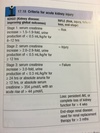Acute kidney injury Flashcards
Prerenal AKI
Impaired perfusion in: Cardiac failure Sepsis Blood loss Dehydration Vascular occlusion
Renal AKI
GN Small-vessel vasculitis Acute tubular necrosis - drugs, toxins, prolonged hypotension Interstitial nephritis - drugs, toxins, inflammatory disease, infection
Post-renal AKI
Urinary calculi Retroperitoneal fibrosis Benign prostatic hyperplasia Prostate cancer Cervical cancer Urethral stricture/valves Meatal stenosis/phimosis
Prerenal AKI - pathophysiology
Hypoperfusion of kidneys leads to acute tubular necrosis Inflammatory changes, focal breaks in tubular basement membrane and interstitial edema Dead tubular cells shed to tubular lumen – tubular obstruction May be profound alteration in renal microcirculation
Anemia and bleeding in AKI
Anemia is common in AKI - blood loss, hemolysis, or decreased erythropoesis In established AKI there is uremia - causes increased risk of bleeding and spontaneous GI hemorrhage
Early recognition is important - how to?
All emergency admissions to hospital should have renal function, BP, temperature and pulse checked on arrival. Risk assessment for developing AKI - Coexisting diseases - DM, vascular disease, liver disease - and drugs - NSAIDs and ACEIs
High-serum creatinine - establish:
AKI? Acute on CKD? Chronic kidney disease?
Prerenal AKI - S&S
Hypotension Tachycardia Delayed capillary refill Signs of early hypovolemia - tachycardia and postural hypotension
Prerenal AKI - lab
Metabolic acidosis Hyperkalemia
Renal AKI - S&S
GN - proteinuria, hematuria Clinical manifestation of underlying disease - SLE, vasculitis Renal biopsy is usually required, along with immunological testing
Drugs causing AKI
Gentamycin Omeprazole Cisplatin Amphotericin B NSAIDs and ACEIs (prerenal AKI)
Definition of AKI
Sudden (and often reversible) loss of renal function Develops over days or weeks Often accompanied by a reduction in urine volume
Criteria for acute kidney injury




